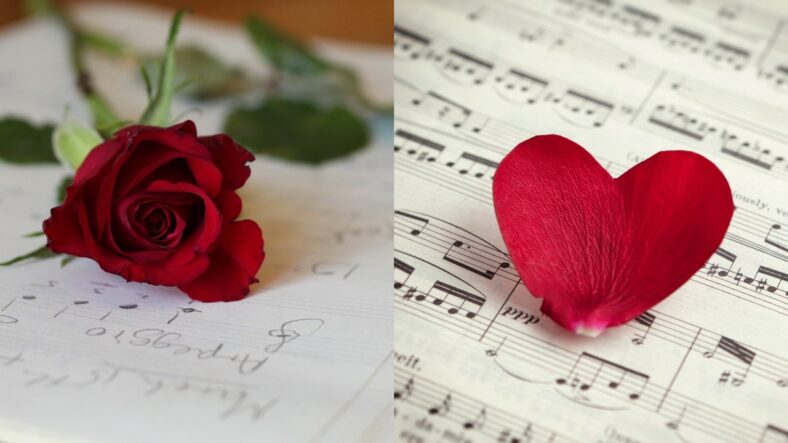How To Write A Love Song (The Ultimate Guide)

To write a captivating love song, start by choosing an emotional theme and draw inspiration from personal experiences. Remember to focus on crafting a memorable title, and hook, and matching the music to your song’s mood.
This is a step-by-step process on how to approach writing a love song. Some of the advice in this article is meant to help with the creative process while also providing useful tips on how to tackle this endeavor.
When writing a love song, you should immerse yourself in the process by first selecting a theme that revolves around love and then embracing your personal experiences and emotions for authenticity. Focus on key elements such as crafting the perfect title and hook to engage your listeners.
A well-structured love song with poetic lyrics can evoke strong emotions while matching the music to create a suitable atmosphere. Approach the editing and revision process diligently and utilize available resources or seek professional assistance to bring your love song to life.
Contents
- 1. Choosing a Theme
- 2. Embracing Personal Experiences and Emotions
- 3. Crafting the Perfect Title and Hook
- 4. Matching the Music to the Love Song’s Mood
- 5. Curating Thoughtful and Poetic Lyrics
- 6. Love Song Structure and Elements
- 7. Recording and Sharing Your Love Song
- 8. Learning from Famous Love Songs
- 9. The Editing and Revision Process
- 10. Utilizing Resources and Seeking Professional Assistance
- Conclusion
1. Choosing a Theme
Choosing a love song theme is an essential first step. While exploring different themes, focus on common topics like adoration, heartbreak, and unrequited love, but remember to offer unique angles to set your song apart. A personal touch and emotional intimacy often makes the song stand out and is more likely to relate to people.
2. Embracing Personal Experiences and Emotions
Embracing personal experiences and emotions (passion) is crucial for writing a believable and relatable love song. Drawing from your own life (past relationships) and genuine emotions adds authenticity to your lyrics, helping you create a deep connection with your audience. By tapping into your personal experiences, you can craft a love song that resonates with listeners and leaves a lasting impact.
3. Crafting the Perfect Title and Hook
Creating a memorable love song requires developing a catchy hook (or chorus) and a captivating title that resonates with listeners. Keep these tips in mind:
- Choose a title that reflects the central theme of your song and captures the audience’s attention.
- Ensure the hook is simple yet memorable and features a catchy tune or memorable lyrics, preferably a catchy vocal pattern and rhyme scheme.
- Repetition is key; make sure your hook appears throughout the song to reinforce its impact.
4. Matching the Music to the Love Song’s Mood
Matching the music to your love song’s mood and theme is vital for creating a cohesive and impactful composition. Focus on these essential aspects:
- Choose instruments that complement the song’s emotions, such as romantic strings for tender moments or energetic drums for passionate expressions.
- Select melodies that support and enhance your lyrics, reinforcing the emotions you’re conveying.
- Incorporate rhythms that evoke the desired mood, be it sensual, joyful, or melancholic.
By carefully combining these musical elements, you’ll create a unified love song that powerfully captures the feelings you want to convey. Remember, this is a whole process where creativity plays a huge part and that requires a lot of attention to detail, so don’t rush it.
5. Curating Thoughtful and Poetic Lyrics
Crafting thoughtful and poetic lyrics is vital for creating a powerful and resonant love song. Keep the following suggestions in mind:
- Strive for a poetic tone, using metaphors (if possible) to express emotions and ideas.
- Create vivid imagery with descriptive language that transports your audience into the world of your song.
- Avoid cliches and corny phrases; instead, find unique ways to express common sentiments.
You don’t have to overly complicate your lyrics as sometimes they are a hit-and-miss. Start with something simple and build the idea gradually. If something comes to mind that is a bit out there, don’t be afraid to implement it.
6. Love Song Structure and Elements
A well-structured love song enhances its emotional impact and is essential for engaging your audience. To effectively organize your song, consider the following elements:
- Verses: Use verses to tell the story and express your emotions or experiences.
- Choruses: Create memorable, repetitive choruses that emphasize the central theme and melody.
- Bridges: Introduce bridges to provide a change of pace and add depth to your song.
Additionally, focus on your melody and chords to create an emotional soundscape that complements your lyrics. Keep the structure balanced and cohesive to ensure a captivating listening experience. And remember – less is more!
7. Recording and Sharing Your Love Song
Recording and sharing your love song is an essential step in the creative process. Starting with a demo, you can receive invaluable feedback from listeners that help refine your song:
- Record a simple demo to capture the essence of your love song, focusing on the vocals and key instruments.
- Share your demo with friends, family, or online communities to gather a diverse range of opinions.
- Listen to the feedback, incorporating constructive suggestions to improve your song and perfect its emotional impact.
By actively seeking input, you’ll grow as a songwriter and bring your love song closer to its full potential. You will most likely end up changing a few things but it will get you one step closer to your goal.
8. Learning from Famous Love Songs
Gaining inspiration from famous love songs can enrich your creative process and help you write a memorable composition. Studying celebrated love songs across various genres can offer valuable insights:
- Use famous love songs as references to understand what elements resonate with audiences and make a song timeless.
- Observe the lyrics, melodies, and musical arrangements that create the unique emotional impact of these iconic pieces.
- Adapt and build upon these successful techniques, molding them to fit your style and vision.
9. The Editing and Revision Process
The editing and revision process is crucial for developing a love song that boasts clarity, cohesion, and emotional impact. Keep the following guidelines in mind when refining your draft:
- Revisit your lyrics to ensure they effectively convey your intended emotions and ideas, making necessary adjustments.
- Assess the overall structure, paying attention to flow and transitions between verses, choruses, and bridges.
- Check for consistency in your song’s tone and melody, ensuring each element contributes to the desired emotional atmosphere.
By meticulously reviewing and refining your love song, you’ll elevate its overall quality and charm, creating a piece your audience will treasure.
10. Utilizing Resources and Seeking Professional Assistance
Aspiring musicians can greatly benefit from utilizing relevant resources and seeking professional assistance to create and perfect their love songs. Consider the following options:
- Explore songwriting courses and workshops to improve your skills and learn from experienced songwriters.
- Access online forums, communities, and collaboration platforms where you can connect with other musicians and share experiences.
- Invest in music production tools and software to enhance the recording process and achieve professional results.
Conclusion
In conclusion, crafting an unforgettable love song involves selecting an emotionally resonant theme, drawing inspiration from personal experiences with a boyfriend or girlfriend, and focusing on strong hooks and titles. To captivate your audience, maintain a well-structured song, create poetic lyrics, and ensure a cohesive mood with complementary music. Record and share your composition to gather valuable feedback, learn from iconic hit songs, and engage in the editing and revision process. Finally, harness available resources and seek professional guidance to refine your songwriting process, resulting in a love song that stirs hearts and leaves a lasting impression.





